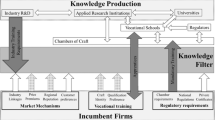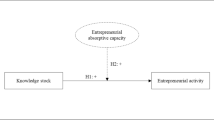Abstract
The knowledge spillover theory of entrepreneurship identifies new knowledge as a source of entrepreneurial opportunities, and suggests that entrepreneurs play an important role in commercializing new knowledge developed in large incumbent firms or research institutions. This paper argues that, knowledge spillover entrepreneurship depends not only on new knowledge but more importantly on entrepreneurial absorptive capacity that allows entrepreneurs to understand new knowledge, recognize its value, and commercialize it by creating a firm. This absorptive capacity theory of knowledge spillover entrepreneurship is tested using data based on U.S. metropolitan areas.





Similar content being viewed by others
Notes
Scholars generally distinguish technology/knowledge transfer from technology/knowledge spillover. Technology transfer refers to the knowledge flow between different parties with compensation based on the market value of the knowledge, and in the case of technology spillover, the knowledge flow is either undercompensated or not compensated at all. However, knowledge is characterized with uncertainty (Arrow 1962). It is difficult to determine the market value of knowledge and thus difficult to identify whether a knowledge flow is a transfer or a spillover (Agarwal et al. 2010).
We appreciate one reviewer’s suggestion that entrepreneurial absorptive capacity can also be tested in an interaction term:\( Entrepreneurship\,=\, \gamma_{1} HumanCapital + \gamma_{2} NewKnowledge\,+\,r_{3} HumanCaptial*NewKnowledge\,+\,\varepsilon_{{}} \). We did find a positive coefficient (significant at the 0.10 level) of the interaction term, consistent with our results in path analysis.
References
Acs, Z. J., Anselin, L., & Varga, A. (2002). Patents and innovation counts as measures of regional production of new knowledge. Research Policy, 31(7), 1069–1085.
Acs, Z. J., & Armington, C. (2006). Entrepreneurship, geography, and American economic growth. New York: Cambridge University Press.
Acs, Z. J., & Audretsch, D. B. (1987). Innovation, market structure, and firm size. Review of Economics and Statistics, 69(4), 567–574.
Acs, Z. J., & Audretsch, D. B. (1988). Innovation in large and small firms: An empirical analysis. American Economic Review, 78(4), 678–690.
Acs, Z. J., Audretsch, D. B., Braunerhjelm, P., & Carlsson, B. (2009). The knowledge spillover theory of entrepreneurship. Small Business Economics, 32, 15–30.
Agarwal, R., Audretsch, D., & Sarkar, M. B. (2007). The process of creative construction: Knowledge spillovers, entrepreneurship, and economic growth. Strategic Entrepreneurship Journal, 1, 263–286.
Agarwal, R., Audretsch, D., & Sarkar, M. B. (2010). Knowledge spillovers and strategic entrepreneurship. Strategic Entrepreneurship Journal, 4, 271–283.
Anselin, L., Varga, A., & Acs, Z. (1997). Local geographic spillovers between university research and high technology innovations. Journal of Urban Economics, 42(3), 422–448.
Anselin, L., Varga, A., & Acs, Z. (2000). Geographic and sectoral characteristics of academic knowledge externalities. Papers in Regional Science, 79, 435–443.
Arrow, K. J. (1962). The economic implications of learning by doing. Review of Economic Studies, 29(3), 155–173.
Audretsch, D. B. (1995). Innovation and industry evolution. Cambridge, MA: MIT Press.
Audretsch, D. B., & Keilbach, M. C. (2006). Entrepreneurship, economic growth and restructuring. In M. Casson, B. Yeung, A. Basu, & N. Wadeson (Eds.), The Oxford handbook of entrepreneurship. New York: Oxford University Press.
Audretsch, D. B., Keilbach, M. C., & Lehmann, E. E. (2006). Entrepreneurship and economic growth. New York: Oxford University Press.
Audretsch, D. B., & Lehmann, E. E. (2005). Does the knowledge spillover theory of entrepreneurship hold for regions? Research Policy, 34(8), 1191–1202.
Braunerhjelm, P., Acs, Z. J., Audretsch, D. B., & Carlsson, B. (2010). The missing link: Knowledge diffusion and entrepreneurship in endogenous growth. Small Business Economics, 34(2), 105–125.
Camisón, C., & Forés, B. (2010). Knowledge absorptive capacity: New insights for its conceptualization and measurement. Journal of Business Research, 63(7), 707–715.
Casson, M. (1982). The entrepreneur: An economic theory. Oxford: Martin Robertson.
Cohen, W. M., & Levinthal, D. A. (1990). Absorptive capacity: A new perspective on learning and innovation. Administrative Science Quarterly, 35(1), 128–152.
Florida, R. (2002). The economic geography of talent. Annals of the Association of American Geographers, 92(4), 743–755.
Florida, R., Mellander, C., & Stolarick, K. (2008). Inside the black box of regional development: Human capital, the creative class and tolerance. Journal of Economic Geography, 8(5), 615–649.
Garson, D. (2011). Path analysis. Retrieved May 31, 2011, from http://faculty.chass.ncsu.edu/garson/PA765/path.htm.
Glaeser, E. L. (1998). Are cities dying? Journal of Economic Perspectives, 12, 139–160.
Griliches, Z. (1979). Issues in assessing the contribution of research and development to productivity growth. Bell Journal of Economics, 10(1), 92–116.
Hecker, D. E. (2005). High-technology employment: A NAICS-based update. Monthly Labor Review, July, 57–72.
Jacobs, J. (1969). The economy of cities. New York: Random House.
Jaffe, A. B. (1986). Technological opportunity and spillovers of R&D: Evidence from firms’ patents, profits, and market value. American Economic Review, 76(5), 984–1001.
Jaffe, A. B. (1989). Real effects of academic research. American Economic Review, 79(5), 957–970.
Jaffe, A. B., Trajtenberg, M., & Henderson, R. (1993). Geographic localization of knowledge spillovers as evidenced by patent citations. The Quarterly Journal of Economics, 108(3), 577–598.
Kim, L. (1998). Crisis construction and organizational learning: Capability building in catching-up at Hyundai Motor. Organization Science, 9(4), 506–521.
Lee, S. Y., Florida, R., & Acs, Z. J. (2004). Creativity and entrepreneurship: A regional analysis of new firm formation. Regional Studies, 38(8), 879–891.
Lucas, R. E., Jr. (1988). On the mechanism of economic growth. Journal of Monetary Economics, 22, 3–42.
Marshall, A. (1920). Principles of economics. London: Macmillan.
Michelacci, C. (2002). Low returns in R&D due to the lack of entrepreneurial skills. The Economic Journal, 113, 207–225.
Mokyr, J. (1990). The lever of riches. New York: Oxford University Press.
Mowery, D. C., & Oxley, J. E. (1995). Inward technology transfer and competitiveness: The role of national innovation systems. Cambridge Journal of Economics, 19(1), 67–93.
Peri, G. (2005). Determinants of knowledge flows and their effect on innovation. Review of Economics and Statistics, 87(2), 308–322.
Qian, H. (2010). Talent, creativity and regional economic performance: The case of China. The Annals of Regional Science, 45(1), 133–156.
Qian, H., & Li, H. (2008). The impact of sector specialization on entrepreneurial activity. In Z. Acs & R. Stough (Eds.), Public policy in an entrepreneurial economy: Creating the conditions for business growth. New York: Springer.
Rauch, J. E. (1993). Productivity gains from geographic concentration of human capital: Evidence from the cities. Journal of Urban Economics, 34(3), 380–400.
Romer, P. M. (1990). Endogenous technological change. Journal of Political Economy, 98(5), S71–S102.
Schultz, T. W. (1961). Investment in human capital. American Economic Review, 51(1), 1–17.
Schumpeter, J. A. (1934). The theory of economic development. Oxford: Oxford University Press.
Shane, S., & Venkataraman, S. (2000). The promise of entrepreneurship as a field of research. Academy of Management Review, 25, 217–221.
Solow, R. M. (1956). A contribution to the theory of economic growth. The Quarterly Journal of Economics, 70(1), 65–94.
Solow, R. M. (1957). Technical change and the aggregate production function. The Review of Economics and Statistics, 39(3), 312–320.
Zahra, S. A., & George, G. (2002). Absorptive capacity: A review, reconceptualization, and extension. Academy of Management Review, 27(2), 185–203.
Author information
Authors and Affiliations
Corresponding author
Rights and permissions
About this article
Cite this article
Qian, H., Acs, Z.J. An absorptive capacity theory of knowledge spillover entrepreneurship. Small Bus Econ 40, 185–197 (2013). https://doi.org/10.1007/s11187-011-9368-x
Accepted:
Published:
Issue Date:
DOI: https://doi.org/10.1007/s11187-011-9368-x




